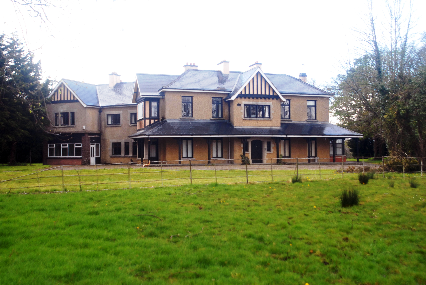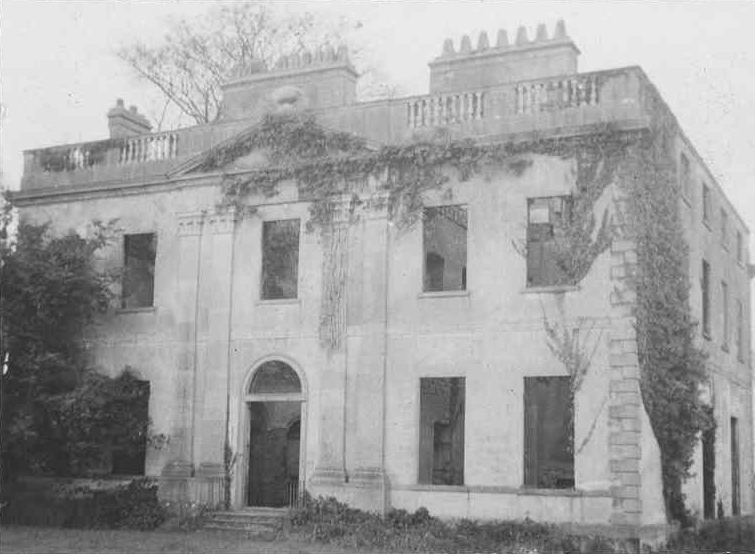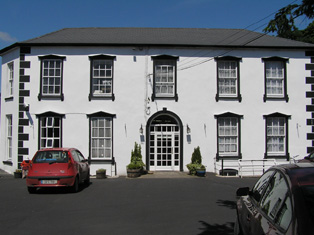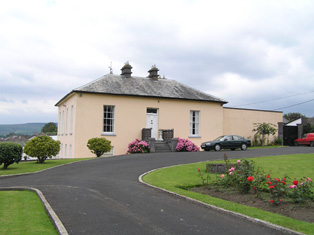Oakfield (Tulla Lower)
Houses within 5km of this house
Displaying 33 houses.
Houses within 5km of Oakfield (Tulla Lower)
Displaying 33 houses.
| House name | Description | |
|---|---|---|
| Athlunkard House | Hamilton Jackson held what was described as a steward's house from Colonel George Wyndham at the time of Griffith's Valuation. It was valued at £14. Weir also describes a house known as Clare Cottage in Athlunkard. | |
| Ballyglass | Weir writes that this was originally a McAdam property. Ballyglass was described as a steward's house at the time of Griffith's Valuation and was held by Andrew Caswell in fee. It was valued at £10. Modernised in the Tudor style in the early 20th century the house is still inhabited. It was valued at £25 in 1906 and was then in the possession of Mark Maunsell. Also known as Rosmadda House. | |
| Blackwater House | Home of the McAdam family in the 19th century before they moved to live in Sussex. The house was valued at £16 in the mid 19th century and was the residence of Philip McAdam. In 1894 Slater refers to it as the residence of Mrs. Caswell. Also known as Springhill House, it is now demolished. | |
| Fairy Hill | This house was situated on the Gore estate and was the residence of John McDonnell in the mid 19th century who held the property from Charles William Gore. It was valued at £14. In 1837 it was inhabited by E. Burnard. Although the house became derelict in the early 20th century it was later reconstructed and is still a residence. | |
| Quinsborough | The original lease of this property was dated 26 September 1712 from the Earl of Thomond to Henry Widenham. The house was built in 1767 by George Quin, son of Valentine Quin and his wife Mary Widenham. Wilson refers to it as the seat of Mr. Quin in 1786. It was the residence of his grandson, Lord George Quin, in 1814. In 1837 Lewis records Quinsborough as the home of Martin Honan, who was elected Lord Mayor of Limerick in 1841. By the mid 19th century Quinsborough was the home of Anne Maria Honan. It was valued at £42 and held in fee. Advertised for sale with 187 acres in November 1868 by Martin Honan Bourke. Modernized in the early 20th century, some of the house contents were auctioned in the [1940s] on the instructions of S.J.K. Roycroft, a director of the Limerick Steamship Company. The house was the residence of the McGoverns in the 1980s. It is still extant. |

|
| Parteen House | At the time of Griffith's Valuation this house valued at £24 was the residence of George Gloster who held it in fee. Weir writes that the house was demolished in the 1920s to make room for the Ardnacrusha hydro-electric dam. | |
| Annesgrove | A 19th century house held by James Joynt from Philip McAdam at the time of Griffith's Valuation when it was valued at £9. | |
| Doonass | In 1786, Wilson noted the building of "a superb and elegant mansion house" by the Massy family beside the River Shannon. The buildings were valued at £75 in the mid 19th century. George Lloyd and Margaret Maunsell Lloyd advertised the sale of their lease of Doonass and 229 acres in June 1855. Following the death of Sir Hugh Dillon Massy in 1870 the house passed to his wife's nephew Colonel John Thomas Massy-Westropp. The house has had a number of different owners in the 20th century, including Mrs Buckley in the 1940s. It was gutted by fire in 2009. |

|
| Newtown | Newtown House situated on the Massy estate was the home of the Walsh family for most of the 19th century. At the time of Griffith's Valuation it was occupied by the Reverend Richard S. Welsh and was valued at £20. It is now a ruin. | |
| Elm Hill House | A home of the Bourchier family in the 18th century. The Bourchiers intermarried with the Massys. The house was located on the Massy estate. Mrs Davis was resident at Elm Hill in 1837 and Joseph Wallplate in the mid 1850s when the house was valued at £12. The home of the Heffernan family in the latter part of the 19th century. The house is still occupied. | |
| Ruanard House | Weir writes that this house was originally built by the Westropps. It was occupied by Captain J. Walsh in 1837 and by Jonas S. Welsh in the mid 1850s when it was valued at £16. Situated on the Massy estate it remained in the possession of the Walsh family until the early 20th century. A house is still extant at the site. | |
| Summerhill | A large 18th century house close to the River Shannon on the Massy estate. Occupied by the Reverend Charles Massey in 1814, Hugh Dillon Massy in 1837 and by Berkeley Vincent in the mid 19th century, when it was valued at £35. It remained the home of this branch of the Vincent family until the early 20th century. The Irish Tourist Association survey of 1942 refers to the demolition of this house "a few years ago". | |
| Errina House | This house located on the west bank of the River Shannon was occupied by Thomas R. Going in 1814, George Vincent in 1837 and at the time of Griffith's Valuation when he held the house valued at £25 from the Reverend Charles Minchin. The house was later occupied by Admiral Hayes O'Grady, father of Standish Hayes O'Grady. The house became the home of the Bourke family in the 1920s and was demolished in the 1940s. There was another large house known as Errina closeby Grid Ref R657 637. | |
| Rose Hill | A house beside the River Shannon occupied by P. O'Callaghan in 1837 and by James O'Grady in the mid 19th century who held it from Mrs O'Callaghan. It was valued at £11. Weir writes that his successor was Henry O'Grady who died in 1902. The house is now a ruin. | |
| Trough Cottage | Trough Cottage was occupied by William Walsh who held it from John Carroll at the time of Griffith's Valuation. It was valued at £16. Weir writes that this was the home of the Misses Bentley in the early 20th century. | |
| Trough House | Trough Castle in the townland of Trough is marked as "in ruins" on the first Ordnance Survey map 1842. Weir writes that Dr Elliott O'Donnell who inherited the county Clare property from Sir Charles O'Donnell in 1870 probably built Trough House in the townland of Roo West. Roo Cottage is marked on the first Ordnance Survey map. | |
| Landscape | A house facing the River Shannon, the original house was built in the early 19th century but was remodelled into the current Tudor style c.1917. The residence of Reverend William Friend in 1814, P.W. Creagh in 1837 and of Standish Thomas O'Grady in the 1850s who held it from Elizabeth Creagh. This house is still extant. In 2013 it was offered for sale. |

|
| Waterpark | A Bindon family home at the beginning of the 19th century. In the mid 19th century the house was located on the estate of Sir Hugh Dillon Massy and was occupied by John Quinn who also held a corn mill. The house was valued at £24. This house was later a home of the Phelps family who vacated it in 1914. It is no longer extant. The Irish Tourist Association surveyor wrote in 1942 that it was being demolished by its owner Mr Latham. | |
| Island House | Lewis refers to a "handsome newly erected cottage on the island" in his description of Castleconnell in 1837. Earlier, in 1786, Wilson refers to Park, situated on an island created by a canal and the river Shannon, as the seat of Sir Richard de Burgho. Island House valued at £17+ was the residence of Sir Richard De Burgho at the time of Griffith's Valuation. He held the property, which was surrounded by nine acres, in fee. In 1894, Slater refers to "The Island" as the property of Lady de Burgho. |

|
| Stormont | Storm-mount was the residence of John Cuffe Kelly esq in 1814 and of Mrs Kelly in 1837. Mrs Kelly was a sister of Francis Drew of Drewscourt. By the time of Griffith's Valuation it was occupied by Joseph Walplate who held it from Sir Richard De Burgho. The buildings were valued at £19+. A house is still extant at this location. In 2022 it was offered for sale. | |
| Worldsend | This house was occupied by Thomas F. Maunsell in 1814 and by James Walplate in the early 1850s. Walplate held the property, valued at £10 and 140 acres from Sir Richard De Burgho. It is still extant and occupied. |

|
| Prospect | The home of Powell in the late 1770s and 1780s, this house was the residence of Sir J. De Burgh Baronet in 1814, of Godfrey Massy in 1837 and of Eyre Lloyd in the early 1850s. Eyre Lloyd held the property from Eyre Powell and it was valued at £46. This mansion house valued at £43 was occupied by Anne G. Crosby in 1906. It is now a ruin. |

|
| Hermitage | Bence Jones writes that this house was built for a banker named Bruce in 1800 but soon afterwards was purchased by the 1st Baron Massy. The main seat of the Massy family in the 19th century, held by them in fee and valued at £70 in the early 1850s. The contents of this house were sold in 1916 and the house was burnt down in June 1920. |

|
| Plassey | Built by Thomas Maunsell, founder of Maunsells' bank, Limerick, and occupied by him in 1814. Inherited by his daughter Mrs Robert Hedges Eyre Maunsell. Occupied by Reuben Harvey in 1837 and at the time of Griffith's Valuation. Harvey held the property from the trustees of Mrs Hedges Maunsell. The residence of Richard Russell in 1868. Home of John Norris Russell in the 1870s. Bence Jones writes that the present Plassey House is "a rambling two storey Victorian Italianate house built by the Russells". This house is now part of the University of Limerick. |

|
| Newgarden | Hugh Ingoldsby Massy is recorded as "of Newgarden" in 1769 and Simon Purdon was resident in the late 1770s and 1786. The widow of Hugh Ingoldsby Massy married Simon Purdon of Tinerana. The Powells of Clonshavoy were located at Newgarden in the early 18th century. A house occupied by William Ryves in 1814 and by Massy Ryves in 1837. By the time of Griffith's Valuation it appears to have fallen into decay. John Dooley occupied a house valued at £1 and Eyre Lloyd held offices valued at £4 from the Earl of Clare. Caleb Powell states that this house was taken down by Eyre Lloyd. | |
| Belmont | Bellmont was the residence of Thomas Grady in 1814 and of Captain Stackpoole in 1837. At the time of Griffith's Valuation it was occupied by John White who held it from Thomas William O'Grady. It was valued at £28 at this time. By the 1870s George Sampson was living at Belmount, Castleconnell. | |
| Woodlands | The residence of J. Tuthill in 1837. This house situated on the Dwyer estate was occupied by Captain John S. Rich who appears to have let the house to lodgers at the time of Griffith's Valuation. The house was valued at £35. In 1942 the Irish Tourist Associaton surveyor records this house as the home of M.D.Shaw "of bacon fame". It still contained a good library and some very valuable paintings and drawings. The Limerick City Museum holds an undated catalogue of the sale of furniture etc from this house belonging to Malcolm D. Shaw 13 Dec [1940s?]. | |
| Shannon Lodge | Occupied by Mr William White circa 1840, by the early 1850s the house was vacant and held from Thomas William O'Grady. It was valued at £16+. Also known as Stradbally House it was destroyed by fire in December 1983. | |
| Corbally House | The Ordnance Survey Name Book records the rebuilding of this house by Poole Gabbet in 1824 at a cost of £1,700. The Gabbets had flour mills closeby. It overlooked the Shannon north of Limerick city and was three storeys high. At the time of Griffith's Valuation it was valued at £35 and was occupied by Thomas Gabbett who held it from Patrick A. Shannon. This house now functions as a nursing home. |

|
| Corbally Park | Built in 1824 by Pierce Shannon for £2,500, this three storey house was held by Patrick A. Shannon in fee at the time of Griffith's Valuation when it was valued at £51. St Munchins College is situated at this location now. A lithograph of this house called Corbally House and the toll bridge is included in the 1856 rental. The house was not included in the sale. | |
| Roseneath Cottage | A villa style house built circa 1820, occupied by Robert Rogers in the early 1850s, valued at £27 and held from Patrick A. Shannon. |

|
| Prospect House | Occupied by Thomas McNamara at the time of Griffith's Valuation, held from Henry Watson and valued at £22. Described in the sale rental of 1856 as a capital house and office on which over £1,000 had been spent on improvements. The original lease dated 1796 was from Thomas Maunsell to Philip Smith for the lives of members of the Watson family. Henry Watson was the tenant in 1856 and Sir Christopher Arbuthnot Maratt in 1877. | |
| Castle Troy | Home of the Matterson family, proprietors of a bacon factory, in the mid 19th century, when the house was valued at £16.5 shillings and of Colonel Richard Arthur Milton Henn, son of Thomas Rice Henn in the early 20th century. The house is labelled Castletroy House on the 1st edition Ordnance Survey map. On the 25-inch edition of the 1890s, however, another house some distance to the south has this title while the original house is labelled Castletroy. Buildings are still extant at both sites. |

|

